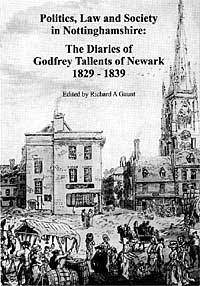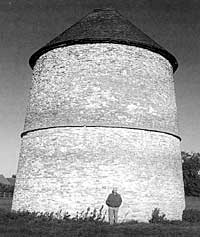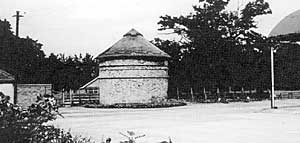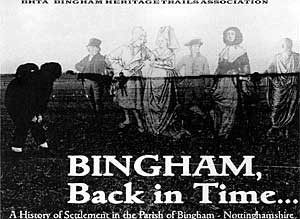Book reviews, Autumn 2010
POLITICS, LAW and SOCIETY IN NOTTINGHAMSHIRE: The Diaries of Godfrey Tallents of Newark 1829-1839

Edited by Richard A. Gaunt, 2010, Nottinghamshire County Council; ISBN 978-902751-65-1
Published by Nottinghamshire County Council in its A4 soft cover house style, this is a most interesting book, especially if read in conjunction with Dr. Gaunt's Thoroton Record Series book, Unhappy Reactionary; The Diaries of the Fourth Duke of Newcastle-under-Lyne 1822-50.
Godfrey Tallents' diary is a record of a young man in his 20s, living in a wealthy and privileged family of Newark solicitors which handled the affairs of the Duke of Newcastle amongst others. Tallents solicitors was founded around 1781 by Phillip Tallents who had moved to Newark from Wingfield in Derbyshire a few years earlier. His youngest son, William Edward built the firm into the leading solicitors in Newark and entered into partnership with Edward Smith Godfrey who had interests in the law and banking. Tallents succeeded Godfrey as Town Clerk of Newark and gained other posts such as Clerk of the Peace, Clerk to the Lieutenancies of Nottinghamshire , Clerk of the Commission of Sewers for the county, Coroner, Alderman, Councillor for Newark East and Clerk of several Turnpike Trusts. In 1814 he became Clerk to the Newark Navigation Commissioners and this post was held by three successive generations of his family for 156 years.
His son, Godfrey, born 1812, followed him into the law having been educated at Charterhouse. He succeeded to many of his father's offices and became very successful in his own right.
He started his diary on returning to England after a period on the Continent, when he was articled in Derby, working alongside William Jessop junior, the son of the well-known engineer.
Dr. Gaunt has selected entries from the diaries which well illustrate the social, business and political life of Newark and the county. Tallents was closely involved in the political machinations of the time, working for
Newcastle's 'Reds' and recorded various incidents during times of electioneering. It will be remembered that W. E. Gladstone represented Newark during this time.
Business affairs are included to show the scope of representation for the landed gentry which the firm held but it is the social life which will probably catch the general reader's attention more than other aspects. There seems to have been an almost incessant round of balls and dinners which the young Tallents attended; there are numerous mentions of very late nights and the consumption of prodigious amounts of alcohol. It was not infrequent that Godfrey arrived home in the early hours of the morning to have a couple or so hours of sleep before needing to be up and at business. On one occasion he lists the fact that he and two companions consumed in one evening, seven bottles of wine, six of Port and one of Sherry.
However, as his business life developed he appears to have calmed down a great deal and the diaries terminate with his marriage in 1839 to his cousin, the first of his three marriages.
This book is a compelling read, very well edited by Richard Gaunt who provides footnotes in explanation of certain matters and, of great help in following the various people mentioned, several pages of biographical notes.
The book covers a wider field than just Newark and follows elections in Nottingham and, occasionally Derby. It is essential reading for anyone interested in the history of our county.
Howard Fisher
Available from the Nottinghamshire Libraries and Archives at £7.50 or by post at £10.50 including p&p from Libraries, Archives and Information, Communities Department, 4th Floor, County Hall, West Bridgford, Nottingham, NG2 7QP. Cheques payable to Nottinghamshire County Council.
NOTES ON NOTTINGHAMSHIRE DOVECOTES
By A. E. Woolrich, 2010

The well-known dovecote at Sibthorpe.
This book of 100 pages, A4, is privately published and probably home printed on an inkjet printer by Mr. Woolrich. It is part of the results of a labour of love carried out between 1985 and 2010.
Between 1985 and 1987, Eddie Woolrich and Gerald Dorrington were responsible for the restoration of the dovecotes at Wollaton Hall and Wollaton village under the supervision of John Severn who was fascinated by dovecotes and who published an introduction to the subject in 1986 in which he listed all the dovecotes that he had seen or been made aware of in Nottinghamshire. Eddie and Gerald used this book, together with a 1927 book by Joseph Whittaker, A Descriptive List of Medieval Dovecotes in Nottinghamshire, as the starting points for their survey of all known dovecotes in the county, both extant and vanished.
The result of their work is a book in which the dovecotes they found information about are listed under the name of the village or town where they were situated. Mr. Woolrich says in the Introduction that the book is not a formalised and structured account of the work the two men carried out but rather a set of jottings and field notes. Nevertheless, what we are offered is a most useful document which greatly adds to the knowledge of these historic and intriguing buildings and which is a great credit to the two men concerned. Sadly, Gerald Dorrington died without being able to see the published results of the work.

The dovecote at Thoroton.
The book's information can be expanded by reference to a database lodged with the Nottinghamshire County Council Historic Buildings Section and with a paper file which includes photographs, survey reports, drawings and correspondences which is to be lodged at the Nottinghamshire County Archive in Nottingham. Additionally about 2,000 photographs can be accessed at the Bassetlaw Museum, Retford, many of them online on the Museum's web site. If seeking these photographs search under 'Local Photographs' then 'Welchman Photographs', subject Agriculture and lastly Agriculture dovecotes. This reviewer needed to contact the Museum before he found the images!
The book contains a useful section of explanation of the terminology connected to dovecotes but I would have liked a section dealing with the history and usage of the structures as part of the Introduction; it is not until well towards the end of the book (page 96) that some information is given but, as this is not a book that most will read through from beginning to end, more likely dipping in and out as particular places are visited, I consider that an expanded section of history would have been most interesting and useful at the front. The book has a chapter of facts and figures which provide added interest and value.
There are some photographs in the book.
These are minor comments and do not detract from an interesting, readable and very valuable addition to the historical factual literature of our county. Eddie Woolrich is to be congratulated in producing this book and thereby making available 25 years of enthusiastic pursuit of the dovecotes of Nottinghamshire. Do buy a copy.
Howard Fisher
Available at £10 plus £1.50 p&p by contacting the author at eddie.woolrich@talktalk.net or by phone on 0115-929-9278.
BINGHAM BACK IN TIME: A History of Settlement in the Parish of Bingham, Nottinghamshire
By Peter Allen, Geoff Ashton and Adrian Henstock. BHTA with Lowdham Writers' Group. 2010. ISBN 978-0-9554359-3-5

Those members who attended the Thoroton AGM at Bingham in April will remember the presentations given by members of the Bingham Heritage Trails Association about their recent Heritage Lottery Funded project on the history of settlement in the parish from pre-historic times to the present. Its principal object was an archaeological field-walking exercise to collect pottery, flints and other artefacts from the surface of all the fields in the parish after ploughing. It is believed this may be one of the few exercises in the country to encompass all periods on a parish-wide basis.
Over 52,000 finds were recovered, the oldest being a 450,000-year old worked flint and the most recent fragments of crockery from a World War II NAAFI canteen.
The project was a major exercise in community archaeology, involving over 100 volunteers who contributed some 6,000 person hours in field-walking during four winter seasons, often in poor weather conditions, in addition to washing, sorting, bagging, and data-basing the finds.
A secondary project was to study historical maps of Bingham, which included translating the written descriptions of landholdings from a 107-page Manorial Survey of 1586 written in Medieval Latin and converting the information into a conjectural map of the farms and cottages and the furlongs and strips of the four open fields.
The results have now been published in a lavishly illustrated full-colour book, including over 70 maps and photographs of typical flint and pottery finds; these will be a valuable guide to identifying similar specimens found throughout the county.
Adrian Henstock
£12.50 from Bingham Library, the Lowdham Bookshop or £15 post paid from BHTA, 3, Quantock Grove, Bingham, Nottingham, NG13 8SE.